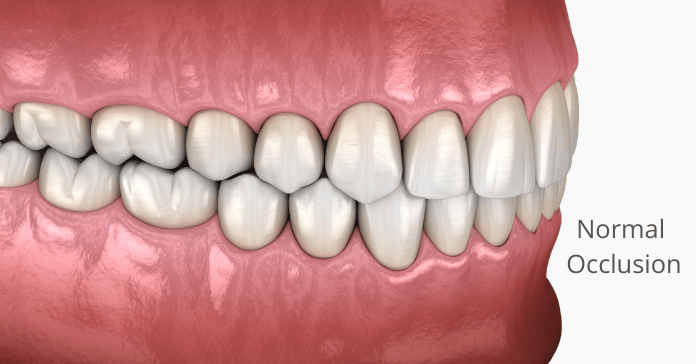Having a perfect smile is something we all desire, and misaligned teeth can adversely impact it. Misaligned teeth are a common dental problem that affects people of any age. While it may seem like a cosmetic issue, having misaligned teeth can lead to various health complications. In this blog post, We will discuss the causes, symptoms, and various treatment options for misaligned teeth.
What is Misaligned Teeth (Malocclusion)?
Occlusion refers to the alignment of teeth and the way that the upper and lower teeth fit together (bite). The upper teeth should fit over the lower teeth with the cusps of the molars fitting into the grooves of the opposite molar.
Malocclusion, also known as teeth misalignment, is a condition wherein the alignment of the teeth on the upper and lower jaws is not correct when the mouth is closed. This results in an improper bite. There are several types of malocclusion, including:
- Overbite, which is when the top front teeth overlap the bottom front teeth
- Underbite, which is when the bottom jaw protrudes further than the top jaw
- Open bite, which is when the top and bottom front teeth don’t touch each other
- Cross Bite, which is when the top teeth fit inside the lower teeth instead of outside
- Crowding, which is when there isn’t enough room for all the teeth to fit inside the mouth
- Spacing, which is when there are gaps between your teeth

What Causes Misaligned Teeth?
Misaligned teeth, also known as malocclusion, are usually a hereditary condition, which means that it is passed down from parents to their children. The child may inherit their parents’ genetic traits, including the jaw shape and size, which can cause teeth misalignment. Other causes may include:
- Early loss of baby teeth or delayed eruption of adult teeth
- Thumb-sucking, which can push the teeth out of alignment
- Using a pacifier or baby bottle for too long during childhood
- Accidents or injuries that affect the teeth and jaw
- Extra teeth, missing teeth, misshapen teeth, or impacted teeth
- A mismatch between the jaw and the size of the teeth
- Mismatch in size between the upper and lower jaws
- Small jaws that can’t accommodate all the teeth
- Mouth breathing, which can cause the upper and lower jaw to develop differently
- Tumors and cysts in the mouth
Symptoms of Misaligned Teeth
Misaligned teeth can be easily spotted by the naked eye. But, other signs may suggest misalignment:
- Uneven bite
- Discomfort when biting or chewing
- Changes in facial appearance
- Repeated biting of inner cheeks or tongue
- Unusual wear on some teeth
- Speech problems such as a lisp
- Mouth breathing instead of nasal breathing.
- Jaw pain or locking jaw joint (temporomandibular joint (TMJ) disorders)
- Neck, shoulder, and back pain
Possible Complications
Misaligned teeth can affect your oral health and overall well-being if left untreated. The teeth become difficult to clean, leading to an increased risk of tooth decay, gum disease, and bad breath.
A misaligned bite can lead to pressure and stress on the jaw joints, which can cause temporal-mandibular joint disorder (TMJ). This condition can cause headaches, jaw pain, and neck pain. Additionally, misaligned teeth can lead to bruxism (teeth grinding), which can cause damage to the teeth and jaw.
Treatment Options for Misaligned Teeth
The treatment options for misaligned teeth vary depending on the severity of the problem. Some common treatments include:
- Braces: Braces use metal brackets and wires to move the teeth into proper alignment over time. It is a long-term solution for misaligned teeth.
- Invisalign: This treatment uses clear, removable aligners to shift the teeth into alignment over time.
- Removal of Teeth: some teeth may need to be removed to make room for the other teeth to move into proper alignment.
- Orthodontic Appliances: There are various types of appliances available that can help correct misaligned teeth. These include headgear, retainers, and expanders.
- Veneers: Veneers are thin shells of ceramic or composite that are bonded to the front of the teeth. This treatment can be used to correct minor misalignments.
- Bonding: Bonding is a process where a composite resin material is applied to the teeth and shaped into place. This can be used to correct minor misalignments. Dental bonding for crowded teeth.
- Jaw Surgery: Jaw surgery is a more invasive procedure that can help correct misalignments caused by problems with the jaw structure.
Visit your orthodontist to discuss the best treatment option for your misaligned teeth. With the right treatment, you can improve your smile and restore proper bite alignment.
Prevention of Misaligned Teeth
Teeth misalignment is usually caused by genetic factors, so it’s difficult to prevent it. However, parents can decrease the likelihood of misaligned teeth in their children by ensuring they receive proper dental care from a young age. Regular check-ups with an orthodontist will help detect potential issues and allow for early intervention.
Also, parents should encourage their children to stop thumb-sucking and pacifier use in their early years. These habits can cause the teeth to move out of alignment.
Conclusion
Misaligned teeth are a common dental problem that affects oral health and appearance. It is usually caused by genetic factors, but other factors may contribute, such as thumb-sucking, extra or missing teeth, and mouth breathing.
If you’re suffering from malocclusion, seek treatment as soon as possible. Depending on the severity of your condition, your orthodontist may recommend braces, Invisalign, orthodontic appliances, veneers, or jaw surgery.
You can’t prevent teeth misalignment because it is often driven by genetic factors. However, parents can protect their children’s teeth by ensuring they receive proper dental care from an early age and discouraging thumb-sucking and pacifier use. Also, regular check-ups with an orthodontist can help detect potential issues and allow for early intervention.